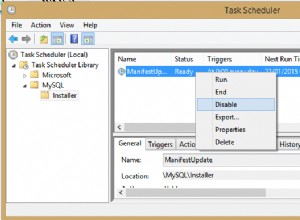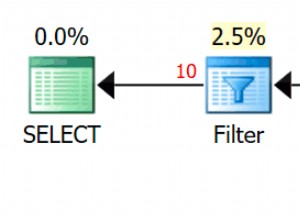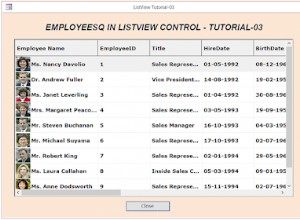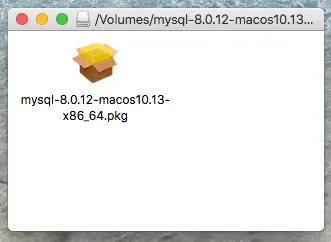Ich sehe, dass dieses Thema ziemlich alt ist, aber es ist immer noch unbeantwortet. Ich bin von Google hierher gekommen und habe keine direkte Antwort auf diese Frage gefunden.
Also, nach ein wenig Recherche fand ich eine recht einfache Lösung.
Alles, was wir brauchen, um unseren Knoten zu verschieben, ist:linke und rechte Position des Knotens, rechte Position des neuen übergeordneten Knotens. Der Knoten kann dann in vier einfachen Schritten an die neue Position verschoben werden:
- Ändern Sie die Positionen des Knotens und aller seiner Unterknoten in negative Werte, die den aktuellen nach Modul entsprechen.
- Bewege alle Positionen "nach oben", die mehr als pos_rechts vom aktuellen Knoten sind.
- Bewege alle Positionen "nach unten", die weiter sind als pos_right des neuen Elternknotens.
- Ändere die Positionen des aktuellen Knotens und aller seiner Unterknoten, so dass er jetzt genau "hinter" (oder "unten") des neuen übergeordneten Knotens ist.
Das ist jetzt Theorie - diese Algorithmusrealisierung in MySQL (Beispiel mit PHP):
-- step 0: Initialize parameters.
SELECT
@node_id := 1, --put there id of moving node
@node_pos_left := 0, --put there left position of moving node
@node_pos_right := 1, --put there right position of moving node
@parent_id := 2, --put there id of new parent node (there moving node should be moved)
@parent_pos_right := 4; --put there right position of new parent node (there moving node should be moved)
SELECT
@node_size := @node_pos_right - @node_pos_left + 1; -- 'size' of moving node (including all it's sub nodes)
-- step 1: temporary "remove" moving node
UPDATE `list_items`
SET `pos_left` = 0-(`pos_left`), `pos_right` = 0-(`pos_right`)
WHERE `pos_left` >= @node_pos_left AND `pos_right` <= @node_pos_right;
-- step 2: decrease left and/or right position values of currently 'lower' items (and parents)
UPDATE `list_items`
SET `pos_left` = `pos_left` - @node_size
WHERE `pos_left` > @node_pos_right;
UPDATE `list_items`
SET `pos_right` = `pos_right` - @node_size
WHERE `pos_right` > @node_pos_right;
-- step 3: increase left and/or right position values of future 'lower' items (and parents)
UPDATE `list_items`
SET `pos_left` = `pos_left` + @node_size
WHERE `pos_left` >= IF(@parent_pos_right > @node_pos_right, @parent_pos_right - @node_size, @parent_pos_right);
UPDATE `list_items`
SET `pos_right` = `pos_right` + @node_size
WHERE `pos_right` >= IF(@parent_pos_right > @node_pos_right, @parent_pos_right - @node_size, @parent_pos_right);
-- step 4: move node (ant it's subnodes) and update it's parent item id
UPDATE `list_items`
SET
`pos_left` = 0-(`pos_left`)+IF(@parent_pos_right > @node_pos_right, @parent_pos_right - @node_pos_right - 1, @parent_pos_right - @node_pos_right - 1 + @node_size),
`pos_right` = 0-(`pos_right`)+IF(@parent_pos_right > @node_pos_right, @parent_pos_right - @node_pos_right - 1, @parent_pos_right - @node_pos_right - 1 + @node_size)
WHERE `pos_left` <= [email protected]_pos_left AND `pos_right` >= [email protected]_pos_right;
UPDATE `list_items`
SET `parent_item_id` = @parent_id
WHERE `item_id` = @node_id;
Bitte beachten Sie - es kann immer noch einige Syntaxfehler im SQL-Code geben, da ich diesen Algorithmus tatsächlich so in PHP verwende:
$iItemId = 1;
$iItemPosLeft = 0;
$iItemPosRight = 1;
$iParentId = 2;
$iParentPosRight = 4;
$iSize = $iPosRight - $iPosLeft + 1;
$sql = array(
// step 1: temporary "remove" moving node
'UPDATE `list_items`
SET `pos_left` = 0-(`pos_left`), `pos_right` = 0-(`pos_right`)
WHERE `pos_left` >= "'.$iItemPosLeft.'" AND `pos_right` <= "'.$iItemPosRight.'"',
// step 2: decrease left and/or right position values of currently 'lower' items (and parents)
'UPDATE `list_items`
SET `pos_left` = `pos_left` - '.$iSize.'
WHERE `pos_left` > "'.$iItemPosRight.'"',
'UPDATE `list_items`
SET `pos_right` = `pos_right` - '.$iSize.'
WHERE `pos_right` > "'.$iItemPosRight.'"',
// step 3: increase left and/or right position values of future 'lower' items (and parents)
'UPDATE `list_items`
SET `pos_left` = `pos_left` + '.$iSize.'
WHERE `pos_left` >= "'.($iParentPosRight > $iItemPosRight ? $iParentPosRight - $iSize : $iParentPosRight).'"',
'UPDATE `list_items`
SET `pos_right` = `pos_right` + '.$iSize.'
WHERE `pos_right` >= "'.($iParentPosRight > $iItemPosRight ? $iParentPosRight - $iSize : $iParentPosRight).'"',
// step 4: move node (ant it's subnodes) and update it's parent item id
'UPDATE `list_items`
SET
`pos_left` = 0-(`pos_left`)+'.($iParentPosRight > $iItemPosRight ? $iParentPosRight - $iItemPosRight - 1 : $iParentPosRight - $iItemPosRight - 1 + $iSize).',
`pos_right` = 0-(`pos_right`)+'.($iParentPosRight > $iItemPosRight ? $iParentPosRight - $iItemPosRight - 1 : $iParentPosRight - $iItemPosRight - 1 + $iSize).'
WHERE `pos_left` <= "'.(0-$iItemPosLeft).'" AND i.`pos_right` >= "'.(0-$iItemPosRight).'"',
'UPDATE `list_items`
SET `parent_item_id` = "'.$iParentItemId.'"
WHERE `item_id`="'.$iItemId.'"'
);
foreach($sql as $sqlQuery){
mysql_query($sqlQuery);
}
Bitte beachten Sie auch, dass der Code möglicherweise optimiert ist, aber ich werde es zur besseren Lesbarkeit so belassen. Ziehen Sie auch das Sperren von Tabellen in Betracht, wenn Sie verschachtelte Sätze in Mehrbenutzersystemen verwenden.
Hoffe, dass meine Nachricht allen hilft, die nach mir nach einer Lösung suchen. Kommentare und Korrekturen sind ebenfalls willkommen.




